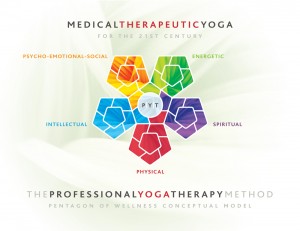
Yoga as Medicine I (Module 8): Emerald Isle, NC
March 5, 2016 @ 8:00 am - March 12, 2016 @ 5:00 pm
 Yoga as Medicine I (Module 8):
Yoga as Medicine I (Module 8):
Module 8 is the first of three on-site modules that make up the practical, applied lab portion of the PYT certification program. This course puts the lectures of Modules 1-7 into motion with application of the concepts learned in those pre-requisite distance modules.
Topics covered include:
Biopsychosocial (BPS) model of assessment and application
Interdisciplinary 15 Precept application and case study analysis
Yoga posture, breath, and meditation prescription using Medical Therapeutic Yoga (MTY) methods (including mudras)
CEUs: 36.00
Description
Module 8 is the first of three on-site intensives which allow the students to assimilate and apply all objectives learned from Modules 1-7. Module 8 allows students to critically evaluate and practice the following objectives, learned in an interactive post-graduate lab format with their peers.
Clinical Objectives
- Apply the 15 MTY precepts to your clinical demographic and practice in order to increase clinical efficacy and safety of yoga prescription.
- Verbalize indications for practicing 86 yoga postures in MTY.
- Demonstrate multidisciplinary knowledge of contraindications for practicing the postures.
- Critically analyze 86 yoga pre-postures and postures and their numerous modifications using blankets, blocks, straps, and other props using the MTY method.
- Integrate 11 breathing principles using the BPS model for postural sequencing through functional application of the 7 principles of physiology and the 4 biomechanical principles.
- Prescribe at least 2 modifications for each posture practiced to make yoga postures useable for all patient and/or wellness based population.
- Demonstrate comprehension of the foundational rules of sequence prescription.
- Verbalize understanding of 5 evidence based postural sequences to improve lumbopelvic and scapulohumeral stabilization, mobilization, global and local stabilizing systems, glenohumeral joint function, stress management, proprioception, breathing, and shoulder and spine pathophysiologies.
- Complete case studies and live BPS patient model assessment with your peers.
- Safely teach a selection of sequenced postures in realtime clinical environment(s) with your peers, using appropriate east/west medical terminology, evidence based rationale, and MTY methods.
- Understand history of yoga in America and how it affects current practice of medical therapeutic yoga.
- Demonstrate knowledge of the guidelines to practice, teaching, manual cuing, and instruction in yoga postures, hand postures, breathing techniques, and meditation.
- Describe the code of ethics for becoming a Professional Yoga Therapist.
- Apply the five obstructions to transformative learning in a case study application to improve patient and therapist communication and satisfaction outcomes.
- Discuss how the BSP model and the 15 precepts can help your patients and clients manage pain, low self-worth, and flagging motivation as both a preventive and therapeutic intervention.
- Teach two breath techniques and two yoga postures in an interactive classroom setting.
- Differentiate between seven breath techniques for use in medical and wellness based programming.
- Demonstrate scientific knowledge of the indications, contraindications, and application of breath techniques.
- Practice the tenets of stabilization in the context of “pre-postures” and yoga postures in an interactive lab setting.
- Practice evidence-based yoga to address multi-joint and systemic stabilization in an interactive lab setting.
- Verbalize how neural mobilization can be safely performed within PYT aligned pre-yoga postures.
- Identify how myofascial and neurovascular restriction can be addressed through the practice of medical therapeutic yoga.
- Using current research, verbalize the importance of using the 4 biomechanical properties in yoga posture analysis.
- Utilizing current science, apply the 7 prerequisites for stabilization to standing postures aligned in the PYT method.
- Demonstrate two PYT blanket folding techniques for modification of seated, supine, and prone postures in order to improve patient outcomes.
- Apply the 15 PYT precepts to 86 yoga postures in order to understand the foundations for the PYT evaluative and therapeutic algorithm.
- Verbalize the importance of yoga practice timing and its effects on the physical, energetic, intellectual, spiritual, and psyco-emotional facets of the mind and body.
- Experience 6 different 60 minute yoga practice sequences in order to understand PYT prescription and rationale.
- Describe how the role of the eight limbed practice, the five obstructions, and individual constitutional analysis determines medical therapeutic yoga prescription in persons with complex medical histories.
- List three different methods, including legal documentation requirements, for implementing business models for free-standing or integrated organizational medical therapeutic yoga practices.
- Understand coding and billing impact practices for medical therapeutic yoga in the PYT method as it applies to licensed health care professionals.
Taught by Ginger Garner, founder, director of PYTI. Teaching assistant, Shelly Prosko, PT, PYT, CPI
Details & to Register HERE
